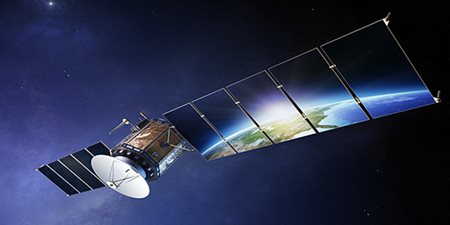Can Space Bring Us Towards Closing the Digital Divide?
If you’re reading this, then I’m willing to bet that you have access to high-speed internet on a daily basis. That connectivity invariably plays a substantial part in your life. Personally speaking, it’s a rare occurrence when I’m not always connected to a strong Wi-Fi network, but if there is no Wi-Fi available, my phone is likely connected to an LTE network.
Internet connectivity and the idea of being always reachable or “always-on” has become the norm in western society and is an expectation across many industries. We use the internet in practically all aspects of our lives; from education to employment, housing to healthcare, to current world events and adorable dog and cat videos.

This need for global connectivity has inspired companies to rethink the way they are distributing broadband services. Companies like Elon Musk's Space X, Jeff Bezos and Amazon’s Project Kuiper, and Telesat out of Canada are working towards moving into using low-earth-orbit (LEO) satellite constellations as the future of telecommunications. This idea has sparked a next-generation ‘space-race’ with the aim of connectivity for all.
While internet access plays an integral role in our society, almost half of the world population does not have access to regular internet. Lack of connectivity is something that affects not only those in the developing world but also affects many of those in western society who live in rural areas. I recently learned some stats on connectivity in North America, and I found them to be staggering, to say the least.
-
Around 39% of rural Americans don’t have broadband access because of it not being available in their area or because of cost.
-
More than 2 million Canadians don’t have access to reliable internet.
-
1 in 5 kids in the United States has trouble completing their homework due to lack of internet.
-
Microsoft found that 163 million Americans don’t have access to high-speed internet.
-
58% of Americans believe access to high-speed internet is a problem in their area.
Recently, I watched an episode of Netflix’s hit show Patriot Act with Hasan Minhaj on internet equality. The sad truth is that there is internet inequality in our society. Suffice to say that from employment to education, having access to a reliable high-speed connection is expected and necessary to succeed.
Watch the episode here for an insightful look into internet equality.
There is a clear digital divide in our society between urban and rural communities as well as between high- and lower-income households. While many of us are expecting faster service and own multiple devices, this is not the standard for many others worldwide. Around 64% of high-earning households in America have broadband service, a smartphone, a desktop or laptop computer, and a tablet. This is in comparison to 18% of those living in lower-income households.
Internet access is actually considered a fundamental human right by the UN, so should we be doing more to make it accessible for everyone?
The Space Race
As previously mentioned, companies are now entering into a ‘space-race’ with the aim of expanded connectivity. In July, the Canadian government announced that they would be giving $85 million in funding to Telesat, the satellite operator focused on bringing high-speed broadband to every Canadian — even those living in rural or remote locations. On top of that, Telesat has goals of connecting everyone world-wide through efficient broadband services.
Some say that the LEO satellite constellations that companies like Telesat are building are to be the future of telecommunications. This is especially true when remote regions are taken into account. While some fiber-optic cables have been laid in remote areas in Canada, the vast distances and complex terrain pose enormous challenges.
Telesat currently has one test satellite in orbit with the final launch planned for 2023. Each satellite will sit approximately 1,000 kilometres above Earth — 35 times closer than traditional satellites. This network of satellites will offer a high-quality connection with low latency anywhere compared to anywhere else on the planet.
Worldwide companies are vying for a piece of the LEO pie. Alongside Telesat, companies like Telstra, Viasat, OneWeb, and of course SpaceX, are working on their own telecommunications satellites.
Elon Musk’s SpaceX is leading the race for satellite broadband. SpaceX is planning a constellation called Starlink which will include around 12,000 satellites that orbit less than 350 kilometres above the Earth's surface. Starlink is the largest satellite constellation currently in the works, set to take a decade to complete, and for a pretty penny — US$10 billion. On May 23, 2019, SpaceX launched the 60 test satellites with their ‘reusable’ and space travel transformative Falcon 9 rocket. Unfortunately, SpaceX has lost communication with three of the satellites, leaving some questioning the method.
The potential for these new broadband services is there, and so is the need. Telesat and Space X are promising that once completed — and even with their high price tags — these projects will offer widespread, low latency connection that will truly be affordable. We can only hope that this is true.
Some critics are pointing out that we should not be contributing to the millions of pieces of space debris that are already in our atmosphere. This debris, often referred to as ‘space junk’, is created by satellite collisions or defunct, drifting satellites. However, the satellites of today are being produced with technology that causes them to ‘deorbit’ once they have reached the end of their lifespan and tighter regulations are being put in place to control the further cluttering around our precious blue dot.
Another Alternative
By now we know that connectivity is crucial and access to the internet for all is, in fact, a basic human right. Perhaps we can get more people connected efficiently with LEO satellites, but what else can we do that doesn’t involve space missions and rockets?
Let's think about Wi-Fi. Wi-Fi has followed the same underlying architecture since its inception in the late 1990s. The creation of dual-band networks is now challenging the standard, single-band wireless network. A dual-band network sends and receives information in two lanes, resulting in a faster, more efficient connection between devices. Think of it is a single-lane road versus a multi-lane highway for Wi-Fi. Edgewater Wireless is leading the way with this initiative and has patented its Multi-Channel, Single Radio (MCSR™) approach to Wi-Fi. This brings the promise of faster connections between the world’s ever-growing number of devices. This system is said to be the future of Wi-Fi.
While this innovation does bring a reduction in latency and a seamless connection, it is still unclear if this will help us to deliver more connections to the world’s people.
I welcome all connectivity innovations and hope that we continue to connect everyone, far and wide. Each step brings us closer to lessening the digital divide and establishes a level playing field for all.

Erika Jones
Erika Jones is a Tech Reporter and Content Marketer with CMSC Media. Erika enjoys combining her creativity with her technical skills through graphic design. She has a background in communications and marketing and has a flair for social media and content creation. Erika is an avid traveller and enjoys seeing firsthand how technology connects us all in business and pleasure.